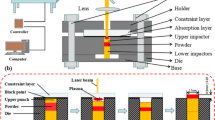Abstract
Different approaches to compact cylinders of titanium aluminide powders by explosively generated shock waves were explored. Two basic compositions of the titanium aluminide powders produced by the rapid solidification rate (RSR) technique were used: Ti-21 wt pct Nb-14 wt pct Al and Ti-30.9 wt pct Al-14.2 wt pct Nb. A double-tube design utilizing a flyer tube was used in all experiments. Experimental parameters that were varied were initial temperature, explosive quantity, and explosive detonation velocity. The major problem encountered with shock consolidation of titanium aluminides was cracking. Titanium aluminide powders were also mechanically blended with niobium powders in one case and elemental mixtures of aluminum and titanium powders in the other case. Enhanced bonding and decreased cracking were observed in both cases. In the former case, the addition of niobium powder provided a ductile binder medium which assisted in consolidation. In the latter case, due to the additional heat generated and melting produced by the shock-induced reactions between Ti and Al, significant improvements in bonding of the titanium aluminide powders were observed.
Similar content being viewed by others
References
D. Shechtman, M.J. Blackburn, and H.A. Lipsitt:Metall. Trans. A, 1974, vol. 5A, pp. 1373–81.
Harry A. Lipsitt, D. Shechtman, and Robert E. Schafrik:Metall. Trans. A, 1975, vol. 6A, pp. 1991–96.
Robert E. Schafrik:Metall. Trans. A, 1977, vol. 8A, pp. 1003–06.
H.A. Lipsitt, D. Shechtman, and R.E. Schafrik:Metall. Trans. A, 1980, vol. 11A, pp. 1369–75.
M.A. Meyers and S.L. Wang:Acta Metall., 1988, vol. 36 (4), pp. 925–36.
S.L. Wang, M.A. Meyers, and A. Szecket:J. Mater. Sci, 1988, vol. 5, pp. 1786–96.
R.G. McQueen, S.P. Marsh, J.W. Taylor, J.N. Fritz, and W.J. Carter: inHigh Velocity Impact Phenomena, R. Kinslow, ed., Academic Press, Inc., New York, NY, 1970, pp. 293–417.
M.L. Wilkins: Lawrence Livermore National Laboratory, Livermore, CA, private communication, 1988.
C.H. Scholz, G. Boitnott, and S. Nemat-Nasser:Pur. Appl. Geophys., 1986, vol. 124, p. 587.
R.A. Graham and D.M. Webb: inShock Waves in Condensed Matter, Y.M. Gupta, ed., Plenum Press, New York, NY, 1986, pp. 831–36.
A.M. Staver: inShock Waves and High Strain Rate Phenomena in Metals, M.A. Meyers and L.E. Murr, eds., Plenum Press, New York, NY, 1981, pp. 865–80.
R.A. Prümmer: inExplosive Welding, Forming and Compaction, T.Z. Blazynsky, ed., Applied Science Publishers, Ltd., London, 1983, pp. 369–95.
Author information
Authors and Affiliations
Rights and permissions
About this article
Cite this article
Ferreira, A., Meyers, M.A., Thadhani, N.N. et al. Dynamic compaction of titanium aluminides by explosively generated shock waves: Experimental and materials systems. Metall Trans A 22, 685–695 (1991). https://doi.org/10.1007/BF02670291
Received:
Issue Date:
DOI: https://doi.org/10.1007/BF02670291




